2018 PEUGEOT EXPERT brake fluid
[x] Cancel search: brake fluidPage 16 of 416
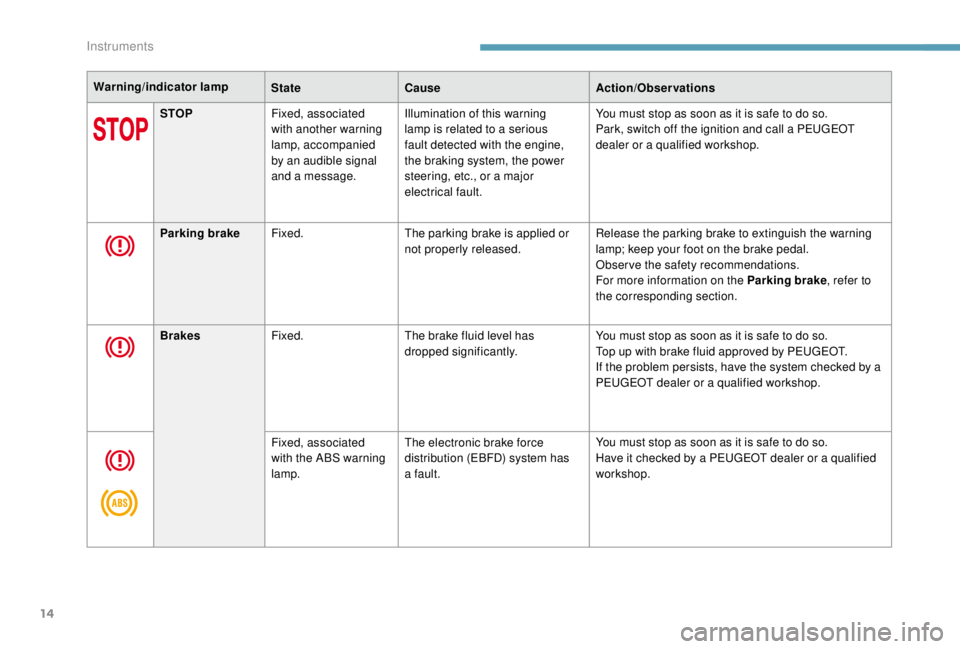
14
Warning/indicator lampStateCause Action/Observations
STOP Fixed, associated
with another warning
lamp, accompanied
by an audible signal
and a message. Illumination of this warning
lamp is related to a serious
fault detected with the engine,
the braking system, the power
steering, etc., or a major
electrical fault. You must stop as soon as it is safe to do so.
Park, switch off the ignition and call a PEUGEOT
dealer or a qualified workshop.
Parking brake Fixed. The parking brake is applied or
not properly released. Release the parking brake to extinguish the warning
lamp; keep your foot on the brake pedal.
Observe the safety recommendations.
For more information on the Parking brake
, refer to
the corresponding section.
Brakes Fixed. The brake fluid level has
dropped significantly. You must stop as soon as it is safe to do so.
Top up with brake fluid approved by PEUGEOT.
If the problem persists, have the system checked by a
PEUGEOT dealer or a qualified workshop.
Fixed, associated
with the ABS warning
lamp. The electronic brake force
distribution (EBFD) system has
a fault. You must stop as soon as it is safe to do so.
Have it checked by a PEUGEOT dealer or a qualified
workshop.
Instruments
Page 249 of 416
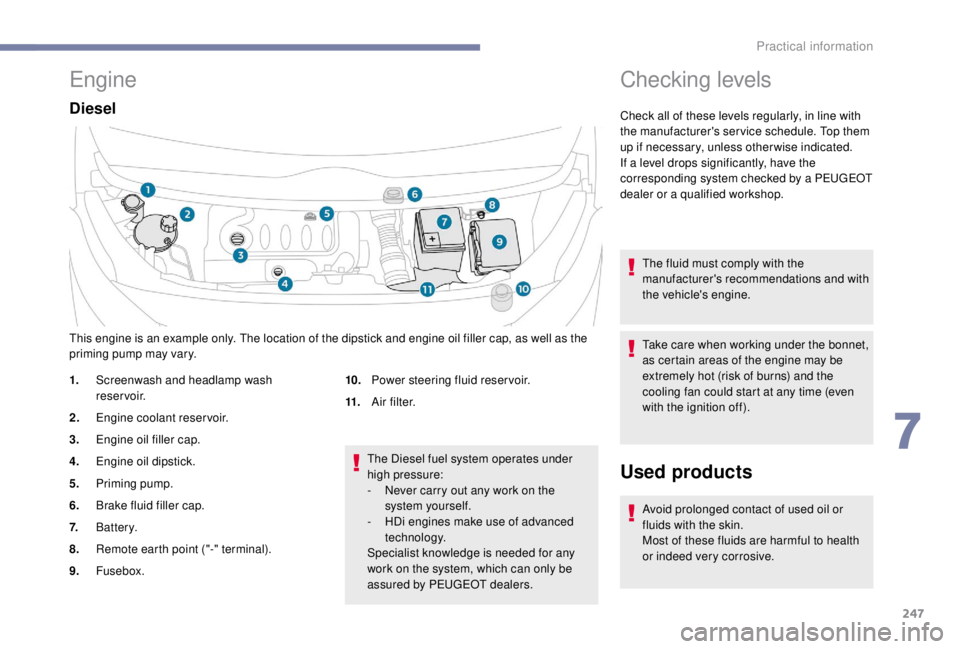
247
Engine
Diesel
The Diesel fuel system operates under
high pressure:
-
N
ever carry out any work on the
system yourself.
-
H
Di engines make use of advanced
technology.
Specialist knowledge is needed for any
work on the system, which can only be
assured by PEUGEOT dealers.
This engine is an example only. The location of the dipstick and engine oil filler cap, as well as the
priming pump may vary.
1.
Screenwash and headlamp wash
reservoir.
2. Engine coolant reservoir.
3. Engine oil filler cap.
4. Engine oil dipstick.
5. Priming pump.
6. Brake fluid filler cap.
7. Battery.
8. Remote earth point ("-" terminal).
9. Fusebox. 10.
Power steering fluid reservoir.
11. A i r f i l t e r.
Checking levels
Check all of these levels regularly, in line with
the manufacturer's service schedule. Top them
up if necessary, unless other wise indicated.
If a level drops significantly, have the
corresponding system checked by a PEUGEOT
dealer or a qualified workshop.
The fluid must comply with the
manufacturer's recommendations and with
the vehicle's engine.
Take care when working under the bonnet,
as certain areas of the engine may be
extremely hot (risk of burns) and the
cooling fan could start at any time (even
with the ignition off).
Used products
Avoid prolonged contact of used oil or
fluids with the skin.
Most of these fluids are harmful to health
or indeed very corrosive.
7
Practical information
Page 251 of 416
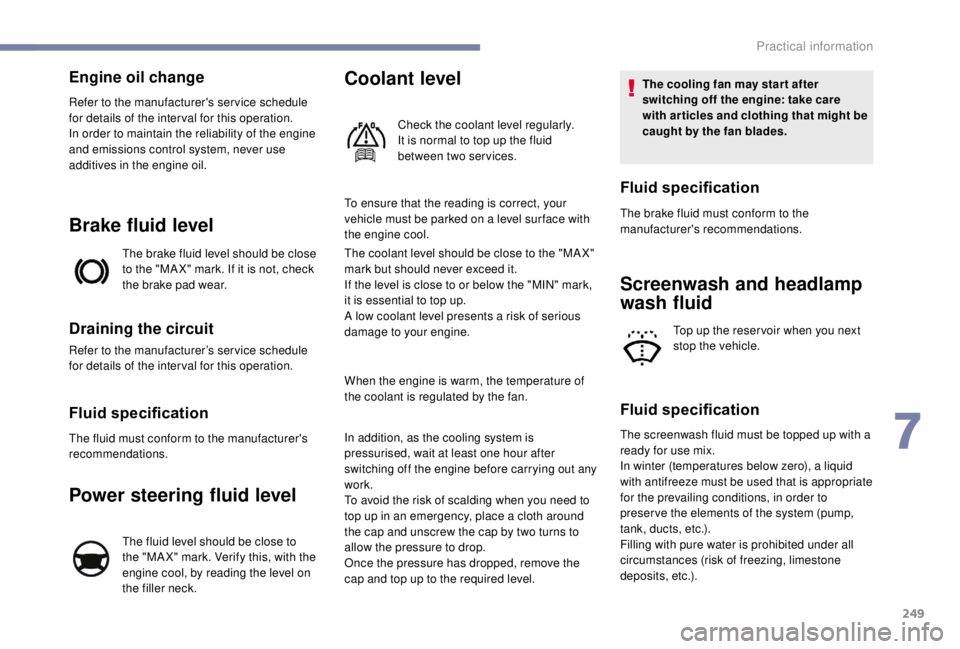
249
Engine oil change
Refer to the manufacturer's service schedule
for details of the inter val for this operation.
In order to maintain the reliability of the engine
and emissions control system, never use
additives in the engine oil.
Brake fluid level
The brake fluid level should be close
to the "MA X" mark. If it is not, check
the brake pad wear.
Draining the circuit
Refer to the manufacturer’s service schedule
for details of the inter val for this operation.
Fluid specification
The fluid must conform to the manufacturer's
recommendations.
Power steering fluid level
The fluid level should be close to
the "MA X" mark. Verify this, with the
engine cool, by reading the level on
the filler neck.
Coolant level
Check the coolant level regularly.
It is normal to top up the fluid
between two services.
To ensure that the reading is correct, your
vehicle must be parked on a level sur face with
the engine cool.
The coolant level should be close to the "MA X"
mark but should never exceed it.
If the level is close to or below the "MIN" mark,
it is essential to top up.
A low coolant level presents a risk of serious
damage to your engine.
When the engine is warm, the temperature of
the coolant is regulated by the fan.
In addition, as the cooling system is
pressurised, wait at least one hour after
switching off the engine before carrying out any
work.
To avoid the risk of scalding when you need to
top up in an emergency, place a cloth around
the cap and unscrew the cap by two turns to
allow the pressure to drop.
Once the pressure has dropped, remove the
cap and top up to the required level. The cooling fan may star t after
switching off the engine: take care
with articles and clothing that might be
caught by the fan blades.
The brake fluid must conform to the
manufacturer's recommendations.
Screenwash and headlamp
wash fluid
Top up the reser voir when you next
stop the vehicle.
Fluid specification
The screenwash fluid must be topped up with a
ready for use mix.
In winter (temperatures below zero), a liquid
with antifreeze must be used that is appropriate
for the prevailing conditions, in order to
preser ve the elements of the system (pump,
tank, ducts, etc.).
Filling with pure water is prohibited under all
circumstances (risk of freezing, limestone
deposits, etc.).
Fluid specification
7
Practical information
Page 253 of 416
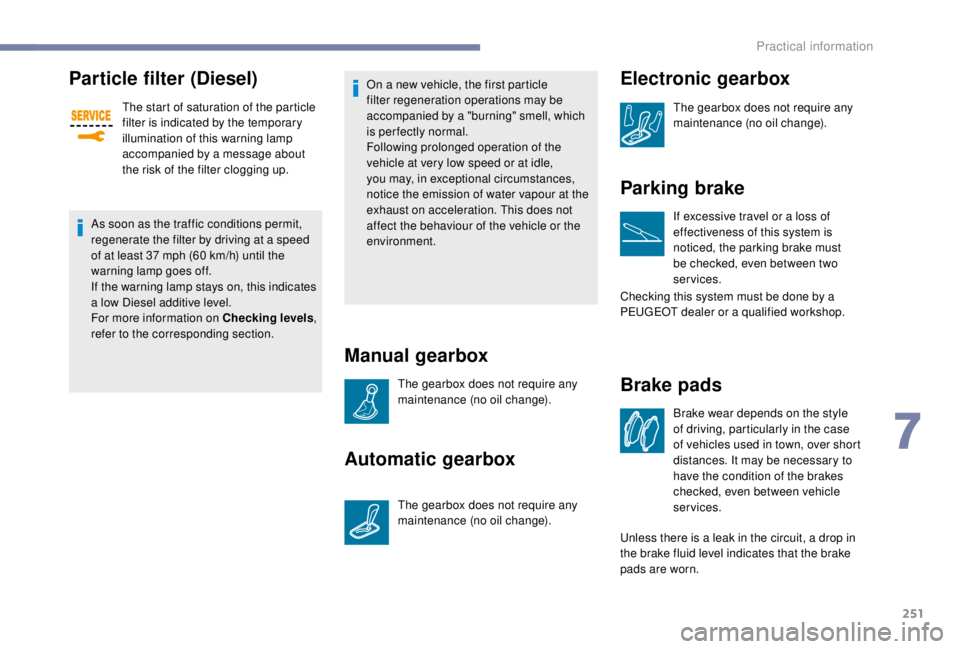
251
Particle filter (Diesel)
The start of saturation of the particle
filter is indicated by the temporary
illumination of this warning lamp
accompanied by a message about
the risk of the filter clogging up.
As soon as the traffic conditions permit,
regenerate the filter by driving at a speed
of at least 37
mph (60 km/h) until the
warning lamp goes off.
If the warning lamp stays on, this indicates
a low Diesel additive level.
For more information on Checking levels ,
refer to the corresponding section. On a new vehicle, the first particle
filter regeneration operations may be
accompanied by a "burning" smell, which
is per fectly normal.
Following prolonged operation of the
vehicle at very low speed or at idle,
you may, in exceptional circumstances,
notice the emission of water vapour at the
exhaust on acceleration. This does not
affect the behaviour of the vehicle or the
environment.
Manual gearbox
The gearbox does not require any
maintenance (no oil change).
Automatic gearbox
The gearbox does not require any
maintenance (no oil change).
Brake pads
Brake wear depends on the style
of driving, particularly in the case
of vehicles used in town, over short
distances. It may be necessary to
have the condition of the brakes
checked, even between vehicle
services.
Unless there is a leak in the circuit, a drop in
the brake fluid level indicates that the brake
pads are worn.
Electronic gearbox
The gearbox does not require any
maintenance (no oil change).
Parking brake
If excessive travel or a loss of
effectiveness of this system is
noticed, the parking brake must
be checked, even between two
services.
Checking this system must be done by a
PEUGEOT dealer or a qualified workshop.
7
Practical information
Page 254 of 416
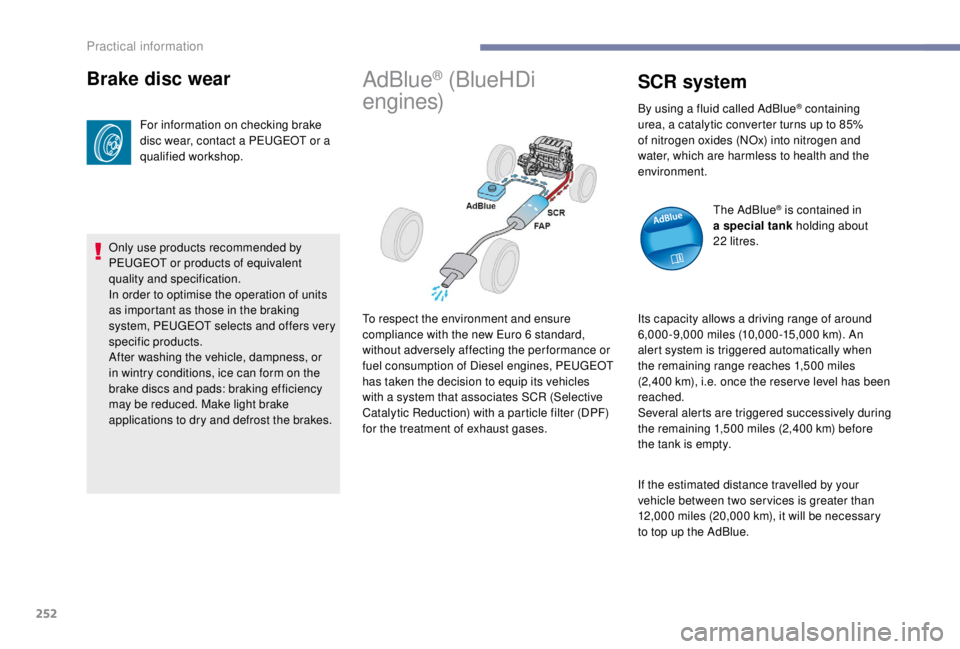
252
Brake disc wear
For information on checking brake
disc wear, contact a PEUGEOT or a
qualified workshop.
Only use products recommended by
PEUGEOT or products of equivalent
quality and specification.
In order to optimise the operation of units
as important as those in the braking
system, PEUGEOT selects and offers very
specific products.
After washing the vehicle, dampness, or
in wintry conditions, ice can form on the
brake discs and pads: braking efficiency
may be reduced. Make light brake
applications to dry and defrost the brakes.
AdBlue® (BlueHDi
engines)
To respect the environment and ensure
compliance with the new Euro 6
standard,
without adversely affecting the performance or
fuel consumption of Diesel engines, PEUGEOT
has taken the decision to equip its vehicles
with a system that associates SCR (Selective
Catalytic Reduction) with a particle filter (DPF)
for the treatment of exhaust gases.
SCR system
By using a fluid called AdBlue® containing
urea, a catalytic converter turns up to 85%
of nitrogen oxides (NOx) into nitrogen and
water, which are harmless to health and the
environment.
The AdBlue
® is contained in
a special tank holding about
22
litres.
Its capacity allows a driving range of around
6,000-9,000
miles (10,000-15,000
km). An
alert system is triggered automatically when
the remaining range reaches 1,500
miles
(2,400
km), i.e. once the reser ve level has been
reached.
Several alerts are triggered successively during
the remaining 1,500
miles (2,400 km) before
the tank is empty.
If the estimated distance travelled by your
vehicle between two ser vices is greater than
12,000
miles (20,000
km), it will be necessary
to top up the AdBlue.
Practical information
Page 407 of 416

309
M
N
O
Markings, identification .................................305
Mat ........................................................ 108, 181
Memorising a speed
..................................... 2
02
Menu
............................................................... 13
Menu, main
....................................................... 4
M
enus (audio)
........................................ 4-5, 4-6
Messages
........................................................ 32
Messages, quick
............................................. 3
2
Mirror, rear view
........................................ 86 - 87
Mirrors, door ...............85-86, 121-122, 225-226
Mirror, vanity
................................................. 109
Misfuel prevention
......................................... 238
Moduwork .................................................. 94-97
Mountings, Isofix
....................16 6 , 16 9 -170, 172
MP3
CD ........................................................... 10
Net, cargo.................................................. 94-97
Net, high load retaining
..........................113 -114
Number plate lamps
..............................279, 281
Oil change
............................................. 24
8-249
Oil consumption
.................................... 248-249
Oil, engine
....................................... 15, 248-249
On-board tools
...................................... 258-260
Opening 90/180/250°
...................................... 78
Opening the bonnet
...................................... 246
Opening the boot
............................... 39, 50, 80
Opening the doors
............39, 50, 63, 66 -70, 79
Opening to 180°
......................................... 7
7-78
LLabels ........................................................ 7, 1 0 5
Labels, identification ..................................... 305
Lane Departure Warning System (LDWS)
.................................... 26, 222
Level, brake fluid
........................................... 249
Level, Diesel additive
............................250-251
Level, engine coolant
........................29 -30, 249
Level, engine oil
.............................. 30, 248-249
Level, headlamp wash
..........................140, 249
Level, power steering fluid
............................249
Levels and checks
..............................
..247, 249
Level, screenwash fluid
........................14
0, 249
Lighting, cornering
................................. 13 4 -13 5
Lighting dimmer
.............................................. 34
Lighting, exterior
........................................... 13 0
Lighting, guide-me home
.......................13 3 -13 4
Lighting, welcome
......................................... 13 4
Loading
......................................................... 243
Loading area fittings
..................................... 112
Load reduction mode
.................................... 243
Load restraint
...............................
.................112
Locating your vehicle
...................................... 43
Locking
.............................. 4
2, 46, 49, 54-55, 60
IIdentification, vehicle .................................... 305
Ignition ................ ............................. 181, 183, 31
Ignition on ...................................................... 183
Immobiliser, electronic
......................44, 60, 185
Indicator, AdBlue
® range ................................. 31
Indicator, coolant temperature ..................29-30
Indicator, engine oil level
................................ 30
Indicator lamps, operation
.............................. 13
I
ndicators, direction
...................................... 132
Inflating tyres
................................................ 305
Inflating tyres (using the kit)
.................. 26
0-265
Instrument panel
............................................. 10
Intelligent Traction Control
............................ 14 6
Internet browser
.............................................. 18
I
SOFIX
........................................... 16 8 -170, 172Key
..................................
39 - 42, 60, 63 - 64, 178
Key, electronic
.................................
39, 183 -18 4
Keyless Entry and Starting
..........
46, 50 - 61, 63 - 64, 181-182, 185
Key with remote control
...............
4
2, 44, 54-55,
178 , 18 5
Kit, hands-free
.................... 2
8 -2 9, 15 -16 , 11-12
Kit, temporary puncture repair
.............. 2
59-265
K
JJack ...............................
............112, 266, 26, 10
Jump starting ................................................ 288Locking from the inside
.............................61- 62
Low fuel level ...................................1
6, 237-238
Lumbar
............................................................88
Headlamps, automatic dipping
....... 25, 13 5 -13 6
Headlamps, automatic illumination ... 13
0, 132-13 4
Headlamps, dipped beam
........................ 2
5 -26, 130, 273 -274, 276
Headlamps, halogen
............................. 273-275
Headlamps, main beam
........................ 2
5 -26, 130, 273, 275 -276
Headlamps, Xenon
............................... 273, 276
Headlamp wash
..............................
.............. 140
Head restraints, front
................................ 91, 93
Head restraints, rear
....................................... 99
Head-up display
.................................... 20
0-201
Heated bench seat
.......................................... 93
Heating
.................................... 11
5 -11 6 , 12 3 -12 7
Heating, additional
........................... 81, 125 -127
Heating, programmable
................... 81, 125 -127
Hill start assist
............................................... 18 6
Horn ............................................................... 145
.
Alphabetical index